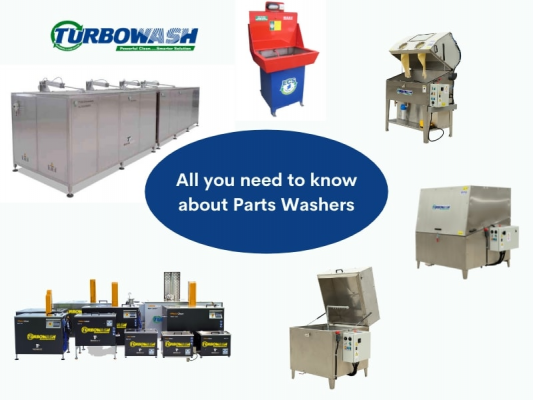A parts washer is a piece of cleaning equipment used to remove contaminants or debris, such as dirt, grime, carbon, oil, grease, metal chips, ink, paint, and corrosion from parts. They are designed to clean and degrease small or large parts in preparation for assembly, inspection, surface treatment, packaging and distribution.
Parts washers may be as simple as a manually operated sink, common in many auto repair shops, or they may be very complex, multi-stage units. Parts washers are also essential in maintenance, repair and remanufacturing operations, from cleaning fasteners, nuts, bolts and screws to diesel engine blocks and related parts, rail bearings, wind turbine gear boxes and automotive assemblies.
Though there are a variety of parts cleaning systems, the majority of systems are divided into two types – aqueous or water cleaners and solvent cleaners.
Aqueous: Aqueous cleaning uses water as its primary component. Acidic or alkaline ingredients are often mixed with water to dissolve water and oil based contaminants. This option is non-flammable and is considered the ‘greener’ option.
Solvent: Solvent cleaners use a chemical process to remove grease, dirt and heavy-duty contaminants from parts. Can be used in industrial heavy duty industrial settings to get rid of thick accumulations of grease, oil, and grime. This option is often flammable or has a low flow point, is ozone depleting and is carcinogenic. This should only be used if water based chemicals are not sufficient or under strict HSE rules.
Parts washers can be divided into three types
Manual – uses a drum or a sink to hand clean parts such as manually operated sinks and high & low pressure cabinet washers.
Semi-automated – Manually loaded and unloaded but the cleaning process is automated, for example spray washers and ultrasonic tanks.
Automated – Parts are automatically moved through the cleaning system using conveying such as multi-stage ultrasonic system.
Types of Parts Washers
Sinks (with a pump hose and brush)
A sink is traditionally the most common and basic of the types of parts washers and is designed for washing individual or a few parts. It consists of a drum with a sink mounted on it that has a solvent or water supply line. Sink and drum models come with a pump and brushes.
High Pressure Cabinet Washers
High pressure manual parts washers are the most common degreaser in the mechanical workshop today. The sturdiness and simplicity of design makes them a valuable tool where manual cleaning and pre-assembly washing of components is still utilised.
The high pressure aqueous cabinet washer utilises a high pressure gun, which is powered by a 60 bar aqueous solution through a pedal powered piston pump. This wash system was developed for technicians that needed to reduce their cleaning time by simply ‘blasting the parts clean’ with a heated aqueous solution. It will remove the most stubborn dirt, greases and carbons. It is used to clean small to medium sized parts.
Spray washers
Spray washers are used to clean medium to large sized parts through a water-spraying industrial washer. It is one of the most common types of washers, and uses high pressure nozzles that spray hot aqueous cleaning solution on the parts. The nozzles are able to clean away heavy or difficult to remove soils, grease, paint, and other contaminants that do not come off easily. Their turntable basket diameters vary from 780mm – 3.2 metres, and the job weight from 150kg – 3000kg.
Spray wash machines are used in the smallest to largest of industrial applications involving the automotive, manufacturing, rail, earthmoving, transport, food production and printing industries.
Ultrasonic tanks
Ultrasonic cleaning uses high-frequency, high-intensity sound waves and agitation in a liquid to remove contaminants from parts submerged in an ultrasonically activated liquid. They come in single stage or multi-stage options and can be semi-automated or fully automated.
It is a unique technology in its ability to remove contaminants that other technologies cannot remove and in its ability to effectively clean areas that are not accessible or easily reachable using other technologies.
Ultrasonic cleaning is suitable for a wide variety of materials, including metals, glass, rubber, ceramics and some hard plastics. It can be used to clean anything from food items, jewellery, surgical instruments to massive engine parts. A single stage ultrasonic tank consists of one main tank and an auxiliary tank grease separating tank. Single stage ultrasonic tanks have a capacity from 30 to 10,000 litres.
A multi-stage ultrasonic cleaner has multiple tanks so parts can manually or automatically be moved from one tank to another quickly and efficiently. Different tanks can be incorporated into the multi-stage automatic system depending on the components to be cleaned, such as an ultrasonic tank, a cold rinse, a hot rinse, and drying.
Turbowash offer a Free consultation to assess your needs and advise the best parts cleaning option for you. Email us for a FREE consultation info@turbowash.ie
We’re committed to providing advanced, efficient, and eco-friendly solutions to meet your cleaning needs. For further inquiries or to make a purchase, feel free to contact us at +353 (0) 1 6978069 or via email at info@turbowash.ie.

